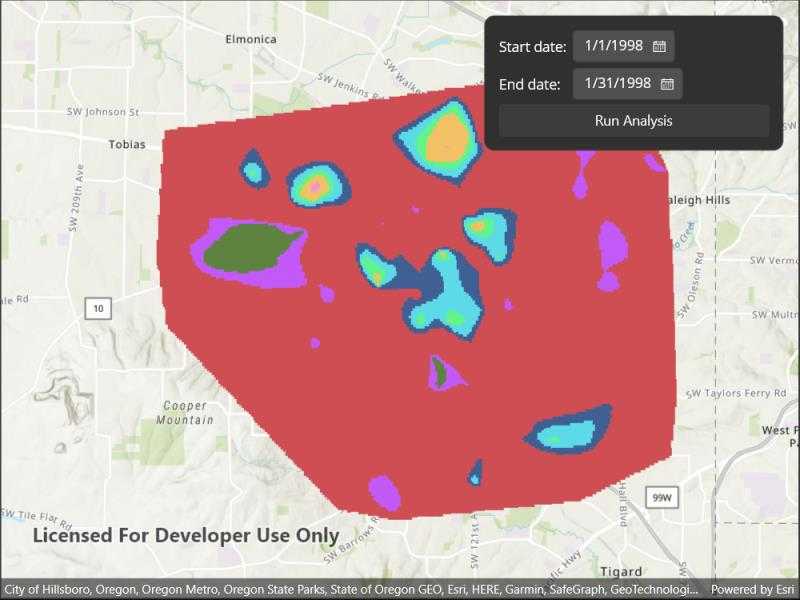Use a geoprocessing service and a set of features to identify statistically significant hot spots and cold spots.

Use case
This tool identifies statistically significant spatial clusters of high values (hot spots) and low values (cold spots). For example, a hotspot analysis based on the frequency of 911 calls within a set region.
How to use the sample
Select a date range (between 1998-01-01 and 1998-05-31) from the dialog and tap on Analyze. The results will be shown on the map upon successful completion of the GeoprocessingJob.
How it works
- Create a
GeoprocessingTaskwith the URL set to the endpoint of a geoprocessing service. - Create a query string with the date range as an input of
GeoprocessingParameters. - Use the
GeoprocessingTaskto create aGeoprocessingJobwith theGeoprocessingParametersinstance. - Start the
GeoprocessingJoband wait for it to complete and return aGeoprocessingResult. - Get the resulting
ArcGISMapImageLayerusingGeoprocessingResult.MapImageLayer. - Add the layer to the map's operational layers.
Relevant API
- GeoprocessingJob
- GeoprocessingParameters
- GeoprocessingResult
- GeoprocessingTask
Tags
analysis, density, geoprocessing, hot spots, hotspots
Sample Code
// Copyright 2022 Esri.
//
// Licensed under the Apache License, Version 2.0 (the "License"); you may not use this file except in compliance with the License.
// You may obtain a copy of the License at: http://www.apache.org/licenses/LICENSE-2.0
//
// Unless required by applicable law or agreed to in writing, software distributed under the License is distributed on an
// "AS IS" BASIS, WITHOUT WARRANTIES OR CONDITIONS OF ANY KIND, either express or implied. See the License for the specific
// language governing permissions and limitations under the License.
using Esri.ArcGISRuntime.Mapping;
using Esri.ArcGISRuntime.Tasks;
using Esri.ArcGISRuntime.Tasks.Geoprocessing;
namespace ArcGIS.Samples.AnalyzeHotspots
{
[ArcGIS.Samples.Shared.Attributes.Sample(
name: "Analyze hotspots",
category: "Geoprocessing",
description: "Use a geoprocessing service and a set of features to identify statistically significant hot spots and cold spots.",
instructions: "Select a date range (between 1998-01-01 and 1998-05-31) from the dialog and tap on Analyze. The results will be shown on the map upon successful completion of the `GeoprocessingJob`.",
tags: new[] { "analysis", "density", "geoprocessing", "hot spots", "hotspots" })]
public partial class AnalyzeHotspots : ContentPage
{
// Url for the geoprocessing service
private const string _hotspotUrl =
"https://sampleserver6.arcgisonline.com/arcgis/rest/services/911CallsHotspot/GPServer/911%20Calls%20Hotspot";
// The geoprocessing task for hot spot analysis
private GeoprocessingTask _hotspotTask;
// The job that handles the communication between the application and the geoprocessing task
private GeoprocessingJob _hotspotJob;
public AnalyzeHotspots()
{
InitializeComponent();
// Create the UI, setup the control references and execute initialization
_ = Initialize();
}
private async Task Initialize()
{
// Create a map with a topographic basemap
MyMapView.Map = new Map(BasemapStyle.ArcGISTopographic);
try
{
// Create a new geoprocessing task
_hotspotTask = await GeoprocessingTask.CreateAsync(new Uri(_hotspotUrl));
}
catch (Exception e)
{
await Application.Current.MainPage.DisplayAlert("Error", e.ToString(), "OK");
}
}
private async void OnRunAnalysisClicked(object sender, EventArgs e)
{
// Clear any existing results
MyMapView.Map.OperationalLayers.Clear();
// Show busy activity indication
MyActivityIndicator.IsVisible = true;
MyActivityIndicator.IsRunning = true;
// The end date must be at least one day after the start date
if (EndDate.Date <= StartDate.Date.AddDays(1))
{
// Show error message
_ = Application.Current.MainPage.DisplayAlert("Invalid date range", "Please select valid time range. There has to be at least one day in between To and From dates.", "OK");
// Remove the busy activity indication
MyActivityIndicator.IsRunning = false;
MyActivityIndicator.IsVisible = false;
return;
}
// Create the parameters that are passed to the used geoprocessing task
GeoprocessingParameters myHotspotParameters = new GeoprocessingParameters(GeoprocessingExecutionType.AsynchronousSubmit);
// Construct the date query
string myQueryString = $"(\"DATE\" > date '{StartDate.Date:yyyy-MM-dd} 00:00:00' AND \"DATE\" < date '{EndDate.Date:yyyy-MM-dd} 00:00:00')";
// Add the query that contains the date range used in the analysis
myHotspotParameters.Inputs.Add("Query", new GeoprocessingString(myQueryString));
// Create job that handles the communication between the application and the geoprocessing task
_hotspotJob = _hotspotTask.CreateJob(myHotspotParameters);
try
{
// Execute the geoprocessing analysis and wait for the results
GeoprocessingResult myAnalysisResult = await _hotspotJob.GetResultAsync();
// Add results to a map using map server from a geoprocessing task
// Load to get access to full extent
await myAnalysisResult.MapImageLayer.LoadAsync();
// Add the analysis layer to the map view
MyMapView.Map.OperationalLayers.Add(myAnalysisResult.MapImageLayer);
// Zoom to the results
await MyMapView.SetViewpointAsync(new Viewpoint(myAnalysisResult.MapImageLayer.FullExtent));
}
catch (TaskCanceledException)
{
// This is thrown if the task is canceled. Ignore.
}
catch (Exception ex)
{
// Display error messages if the geoprocessing task fails
if (_hotspotJob.Status == JobStatus.Failed && _hotspotJob.Error != null)
{
await Application.Current.MainPage.DisplayAlert("Geoprocessing error", "Executing geoprocessing failed. " + _hotspotJob.Error.Message, "OK");
}
else
{
await Application.Current.MainPage.DisplayAlert("Sample error", "An error occurred. " + ex.ToString(), "OK");
}
}
finally
{
// Remove the busy activity indication
MyActivityIndicator.IsRunning = false;
MyActivityIndicator.IsVisible = false;
}
}
}
}